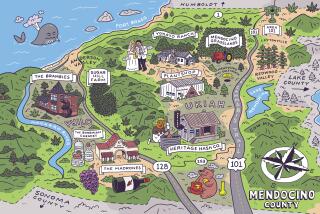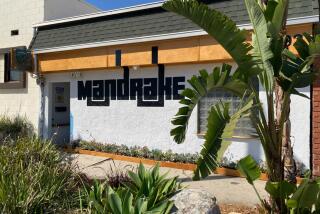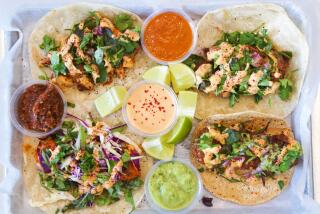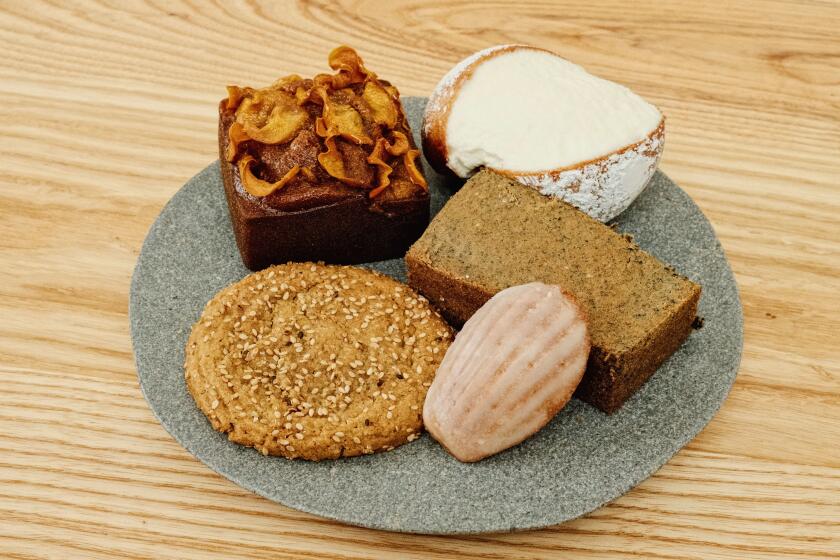Sober times for artisan liquor makers
When Melkon Khosrovian and his culinary-school-trained wife, Litty Mathew, founded Modern Spirits in Monrovia five years ago with the goal of making and selling their own artisan vodkas, they focused on finding just the right balance of Belgian chocolate to orange zest and celery to Malabar peppercorns. They figured well-honed palates and “beautiful, expensive bottles” would be enough to successfully enter the burgeoning artisan distilling market.
They were hardly prepared for many of the day-to-day challenges, such as navigating state liquor regulations, battling with large spirits companies for retail store shelf space and persuading consumers to pay top dollar for a hand-crafted product. As Khosrovian and many of his juniper berry-obsessed colleagues have discovered, the daydreams of selling small-batch, hand-crafted spirits on the merits of taste alone are hardly reality in a business dominated by large corporate distillers with deep advertising pockets that offer similar, and often less expensive, products.
Although finding a niche in a market dominated by brand loyalty may not be a new challenge, many artisan distillers have found that the tight economy has made entering the market with their often pricier spirits even trickier.
But recently, several new artisan distilleries, including Ballast Point in San Diego and central Washington’s Ellensburg Distillery, as well as small spirits companies like Modern Spirits (technically not a distillery because the hard alcohol is purchased, then infused with herbs and flavorings), have learned to focus more time finding the best business model and obsessing a little less over the 70% cacao chocolate.
Learning curve
That even the smallest distillery needs to operate as a viable business is hardly a revolutionary concept, but for many of these artisan producers, making a profit is still a difficult proposition.
“When people call me about building a distillery, I don’t tell them what to make, I tell them to diversify,” says Bill Owens, founder of the Hayward, Calif.-based American Distilling Institute and the leading industry consultant. That diversification might include broadening their product portfolio to include various spirits (whiskey, gin, vodka) or building more visitor-friendly facilities as wineries often do.
“Build a wedding chapel, a boccie ball court -- I don’t care,” Owens says. “You need to build the romance into your product to sell it. . . . these guys don’t always get that.”
Still, Owens says the fact that many small producers struggle in their early years hasn’t slowed industry growth. He estimates that the number of craft distilleries in the United States has grown from fewer than 60 less than seven years ago to more than 200 today. “Where these new distilleries are struggling now is the retail markets.”
Owens points to Ballast Point Spirits as an example of a recently opened distillery that has so far avoided the small-business make-what-you-love trap. “These guys love whiskey, but they’re making rum [and gin] because they know that’s what they can sell.”
Ballast Point owner Jack White says the decision to release those spirits first was simply a matter of financial timing. Gin requires no aging, rum only a few months. “With gin, the art of the flavor is all in infusing the botanicals as you distill . . . and rum doesn’t age very long,” he says.
Although whiskey is still being planned, it isn’t the current priority. “We have the luxury of taking baby steps, not worry about sustaining our investment,” says White, referring to his other businesses -- a home brew shop and Ballast Point Brewery -- that have funded the spirits expansion (the distillery is in a corner of the brewery). “Whiskey is trickier to get just right and takes a long time to age -- when it comes, it comes.”
“You need a quick way to get to market when you’re starting out,” agrees Berle “Rusty” Figgins Jr., Ellensburg Distillery’s co-owner and distiller. In September, the distillery, which is located in Washington’s Columbia Valley wine region, released its first spirit, a South American-style pisco (un-aged brandy made from wine grapes).
“We knew we wanted to use leftover local wine grapes, but we had to figure out how,” Figgins says. “Pisco is a popular category right now, so it also has that consumer appeal.”
New lines
For others, it has taken a few years to find that niche market. Modern Spirits has begun moving to all-organic products.
“We noticed that all of our local partners started going organic,” says Khosrovian of Modern Spirits’ local restaurant and bar clients, including Akasha, Ammo and the Edison. “It was like they were all sent a memo on the same day.”
In 2008, the couple added an organic label, Tru Organic Spirits (gin and flavored vodkas), followed by Fruit Lab Organic Liqueurs in 2009, and launched a new line of organic rum last week. They’ve also reoriented their sales push toward bars and restaurants rather than tougher-to-crack retail.
“We were two-thirds selling to retail stores in the beginning. Now we’re almost entirely selling organics directly to bars and restaurants,” Khosrovian says. “It wasn’t where we thought we’d focus our effort, but we had to swim.”
Khosrovian says sales have more than doubled since the couple launched the lines. In fact, the shift to organics has proved so successful that the couple is closing their original Modern Spirits line later this year.
For companies that opened more recently, the economy has been the more pressing problem.
“You can’t make a living off two little esoteric vodkas, I always knew that,” says Michael Sherwood, owner of Dundee, Ore.-based Sub Rosa Spirits, which specializes in saffron- and tarragon-infused vodkas. “But I thought my infusions would be better accepted.”
After a successful late 2007 launch, Sherwood had hoped by now to buy his own distillery (he has been leasing space in various Portland distilleries to make his vodka infusions). But he says investors are harder to come by these days, so he hasn’t been able to take the distillery plunge.
The retail market has gotten tougher too.
“Here you are today in a small liquor shop trying to convince a customer buying $40 single-vineyard Pinot Noirs that spending $30 on a vodka you can sip for months really isn’t all that much money,” he says.
Despite the day-to-day struggles, the American Distilling Industry’s Owens expects the artisan distilling boom to continue in 2010.
“We’ll get another 30 or so this year, I expect,” he says. “If their grandfather was a moonshiner, they can’t stop themselves. They’ll find a way.”
For the craft producers who are already knee-deep in gin and vodka, the immediate future is less certain.
“We are probably going to go through a pretty good shakeout and lose some artisan distillers over the next year or two,” Khosrovian says. “But we’ll come out with much stronger players overall.”
More to Read
Eat your way across L.A.
Get our weekly Tasting Notes newsletter for reviews, news and more.
You may occasionally receive promotional content from the Los Angeles Times.










